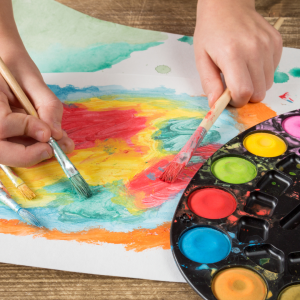Keep your little artists safe
 Coloring and painting provide a creative outlet for people of all ages, especially children, to express themselves freely and imaginatively. Through the use of colors and strokes, individuals can unleash their creativity, channel their emotions, and engage in a calming and therapeutic activity. For children, coloring and painting offer a sense of accomplishment and mastery as they see their art come to life. It allows them to explore their ideas, develop fine motor skills, and learn about spatial awareness and color theory in a fun and interactive way. Additionally, the process of coloring and painting can be a meditative and relaxing experience, providing a break from the hustle and bustle of everyday life. Overall, the joy and fulfillment that coloring and painting bring stem from the ability to create something unique and beautiful, making it a beloved pastime for children and individuals of all ages.
Coloring and painting provide a creative outlet for people of all ages, especially children, to express themselves freely and imaginatively. Through the use of colors and strokes, individuals can unleash their creativity, channel their emotions, and engage in a calming and therapeutic activity. For children, coloring and painting offer a sense of accomplishment and mastery as they see their art come to life. It allows them to explore their ideas, develop fine motor skills, and learn about spatial awareness and color theory in a fun and interactive way. Additionally, the process of coloring and painting can be a meditative and relaxing experience, providing a break from the hustle and bustle of everyday life. Overall, the joy and fulfillment that coloring and painting bring stem from the ability to create something unique and beautiful, making it a beloved pastime for children and individuals of all ages.
There’s no doubt about it: Most children love art! But each year, children end up in emergency rooms due to accidents and mishaps while working on art projects at home.
Did you know that even those art supplies labeled as ‘non-toxic’ can have harmful effects if a child uses them in an unintended manner? That’s why adequate supervision is a must when allowing children to do art projects at home. It’s a good idea to keep art supplies such as paint and glue in a cabinet that’s out of reach of the youngest children. Another preventative measure: When selecting supplies, look for those designed for children that have the AP or CL seal from the Art and Creative Materials Institute (ACMI).
While your children are working on an art project, be on the lookout for hazards in the “workshop.” You may not think of your kitchen or living room as a production zone. Even so, when you’re applying glue and paint and cutting and assembling paper and other materials, it often involves chemicals and sharp objects. Chemicals can be absorbed by a child in a number of different ways. That’s why you’ll want to discourage children from applying paint to their skin unless it’s paint specifically for that type of use. And don’t serve a meal or snacks during an art project. Encourage children to thoroughly wash their hands after working with art supplies.
Don’t forget that babies and young children experience life as one long tasting adventure. Whatever is nearby may go directly into the mouth at any time. Preschoolers in particular have a penchant for putting objects in their mouths. And just like little children, animals can get into trouble in a matter of seconds. Rover may get curious and decide to sniff that glue-laden spoon you just set down on the table. Taking the dog to the vet on the spur of the moment can definitely put the chill on the fun.
For more information about art supply safety, check out the U.S. Consumer Product Safety Commission’s Art and Craft Safety Guide.








